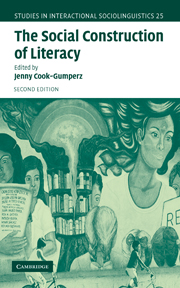Book contents
- Frontmatter
- Contents
- List of figures
- List of tables
- List of contributors
- Preface
- Acknowledgments
- 1 The social construction of literacy
- 2 Literacy and schooling: an unchanging equation?
- 3 Interactional sociolinguistics in the study of schooling
- 4 The language experience of children at home and at school
- 5 Narrative presentations: an oral preparation for literacy with first graders
- 6 Differential instruction in reading groups
- 7 Organizational constraints on reading group mobility
- 8 Developing mathematical literacy in a bilingual classroom
- 9 Spoken language strategies and reading acquisition
- 10 Speaking and writing: discourse strategies and the acquisition of literacy
- 11 The implicit discourse genres of standardized testing: what verbal analogy items require of test takers
- References
- Author index
- Subject index
10 - Speaking and writing: discourse strategies and the acquisition of literacy
Published online by Cambridge University Press: 05 June 2012
- Frontmatter
- Contents
- List of figures
- List of tables
- List of contributors
- Preface
- Acknowledgments
- 1 The social construction of literacy
- 2 Literacy and schooling: an unchanging equation?
- 3 Interactional sociolinguistics in the study of schooling
- 4 The language experience of children at home and at school
- 5 Narrative presentations: an oral preparation for literacy with first graders
- 6 Differential instruction in reading groups
- 7 Organizational constraints on reading group mobility
- 8 Developing mathematical literacy in a bilingual classroom
- 9 Spoken language strategies and reading acquisition
- 10 Speaking and writing: discourse strategies and the acquisition of literacy
- 11 The implicit discourse genres of standardized testing: what verbal analogy items require of test takers
- References
- Author index
- Subject index
Summary
The writer is a lonely figure cut off from the stimulus and corrective of listeners. He must be a predictor of reactions and act on his predictions. He writes with one hand tied behind his back being robbed of gesture. He is robbed too of his tone of voice and the aid of clues the environment provides, he is condemned to monologue; there is no one to help out, to fill the silence, put words in his mouth or make encouraging noises.
(Rosen 1971:142)This heartfelt comment comes from a well‐known researcher on children's writing, in his study of the language of primary‐school children. Rosen's comment identifies a central problem for all writers: the need to create an imaginary audience. This task is often difficult for any writer, but is perhaps especially so for children, since it requires of the writer the special effort of distancing oneself from the present context into a non‐existent yet imagined time and place. Such a transposition of self in time and space requires the writer to make an inferential leap between placing the words on the page and their ultimate reception thereafter at some unspecified time and place. Work with children's writing in the early grades suggests that the more that can be done to reduce this leap by providing specific cues to audience reception for children, the easier the task of placing words on the page might be.
- Type
- Chapter
- Information
- The Social Construction of Literacy , pp. 245 - 263Publisher: Cambridge University PressPrint publication year: 2006
- 1
- Cited by



